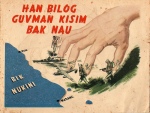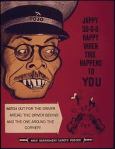Sources :
wikipedia
http://changingminds.org/techniques/propaganda/propaganda_history.htm
Activity 3 : Major events of the 20th century
Propaganda
The use of the word ‘Propaganda’ first occurred in 1622 when Pope Gregory XV established the Sacred Congregation for Propagating the Faith.
The best description of propaganda I have seen is from Gareth Jowett and Victoria O’Donnell
“Propaganda is the deliberate, systematic attempt to shape perceptions, manipulate cognitions, and direct behaviour to achieve a response that furthers the desired intent of the propagandist.”
Over the 20th Century propaganda has had a huge impact on people and nations, allowing governments to almost control the beliefs of the populace, draw attention away from errors they made, or to justify what atrocities they sanction.
In 1933 Adolf Hitler realised the potential that propaganda had and decided to exploit it by appointing Joseph Goebbells as Minister of Propaganda for the Nazis. After the Nazi party came into power in 1933, one of the first acts undertaken by Goebbells was to burn all literature which resulted, on May 10th 1933, in the burning of 25,000 volumes of ‘un-German’ books.
The impact of propaganda is quite large, it would have made the ‘sheep’ of the nation believe whatever was on a poster, but probably spark great amounts of anger from people who oppose these views, or whom the views attack. The impact of fascism or more specificly the impact the nazi party had on the german people is very interesting
(This link does not represent my opinion.)
http://www.johndclare.net/Nazi_Germany3.htm)
Psychoanalysis
Is a theory founded by Sigmund Freud exploring the unconscious and the effect is has on our conscious mental health, he beleived that by releasing trauma or repressed memories he could gain insight into the mind and how it works.
The basic tenets of psychoanalysis
- human behavior, experience and cognition are largely determined by irrational drives;
- those drives are largely unconscious
- attempts to bring those drives into awareness meets defense (resistance) in many different forms;
- beside the inherited constitution of personality, one’s development is determined by events in early childhood;
- conflicts between conscious view of reality and unconscious (repressed) material can result in mental disturbances such as neurosis, neurotic traits, anxiety, depression etc.;
- the liberation from the effects of the unconscious material is achieved through bringing this material into the consciousness (via e.g. skilled guidance)
another phrase that comes to mind when thinking of the austrian neurologist is the freudian slip
2) Freudian Slips
” Unconscious thoughts and feelings can transfer to the conscious mind in the form of parapraxes, popularly known as “Freudian slips” or slips of the tongue. We reveal what is really on our mind by saying something we didn’t mean to.
For example, a nutritionist giving a lecture intended to say “We should always demand the best in bread”, but instead said “bed”. Another example is where a person may call a friend’s new partner by the name of a previous one, whom we liked better.
Freud believed that slips of the tongue provided an insight into the unconscious mind and that there were no accidents, every behaviour (including slips of the tongue) was significant (i.e. all behaviour is determined). ”
taken from simplypsychology.org/psychoanalysis.html
psychoanalysis has probably changed art more than we know it, after all a lot of it is unconscious, trying to make a material or canvas appear like another object which sparks a reaction in our brain, for instance almost instantly you can tell the mood a painting is trying to express through the composition, colour, and even symbology. This could be compared with the Rorschach ink blots, the blots themselves are random, its beleived that the images we see are projections of our unconscious onto the paper which can then be read into by the analyst.

Theory of Relativity-
The theory of relativity was developed by Albert Einstein and published in the early 20th century, this superseded the previous theory of mechanics demonstrated by Isaac Newton, however Einstein admitted rather modestly that his work could not take precedence over Newton’s. This wasnt the case, einsteins theory drastically changed perceptions in science, i have to quote from wikipedia to fully explain, and understand myself, the principles of this theory
‘The theory of relativity overturned the concept of motion from Newton’s day, by positing that all motion is relative. Time was no longer uniform and absolute. Physics could no longer be understood as space by itself, and time by itself. Instead, an added dimension had to be taken into account with curved spacetime. Time now depended on velocity, and contraction became a fundamental consequence at appropriate speeds’
Physics was greatly affected, and was advanced a great deal thanks to relativity. A new depth into the understanding into the science of elementary particles and their fundamental interactions, this was also a catalyst for the birth of the nuclear age.

The Atomic Age-
Also know as the Atomic Era, this title denotes the period following the detonation of the first atomic bomb ‘Trinity’ on July 16 1945, an explosion almost beyond comprehension, equivalent to 20,000 tonnes of TNT.

(600ft/200m wide, the black spec that can be seen are trees)
Even though nuclear science was being practised before this, the bombing of Hiroshima in Japan counted as the first ‘practical’ use of nuclear technology on a large scale and subsequently changed the socio-political ideology and the course of technological development. At the time nuclear technology was seen to be the embodiment of progression and modernity.
Unfortunately this was not the case for the Atomic Era, instead it caused immense problems; socially, the arms race, the Chernobyl disaster and of course the Cold War. Not to mention the catastrophe caused in the areas affected by nuclear fallout, genetic deformation, and the disposal of nuclear waste has been an issue since its discovery.
Arms Race-
This term refers to the competition between two or more parties for the best armed forces. Each party tries to out-do the other by producing larger numbers of weapons, vehicles, and more advanced military technologies. In this day and age the term is used to describe any frivolous competition where there is no ultimate goal, only to be ‘better’ than your competitor.

1891-1919 was the period which the WWI arms race took place, this arms race was between several European countries but was mainly between Britain and Germany. Germany’s envy of the British Navy lead to the costly building competition of the ‘Dreadnought’ class battleship. This ship soon became a symbol of national power, and this military tension continued to 1914 when the tension surfaced and the World War was a result. Following WWI the allies began a new arms race amongst themselves, until the Washington Naval Treaty was enforced. This treaty included; the United States of America, the British Empire, the French Third Republic, The Kingdom of Italy and the Empire of Japan. The treaty was intended to limit the already vast naval fleets of all 5 participating parties.




